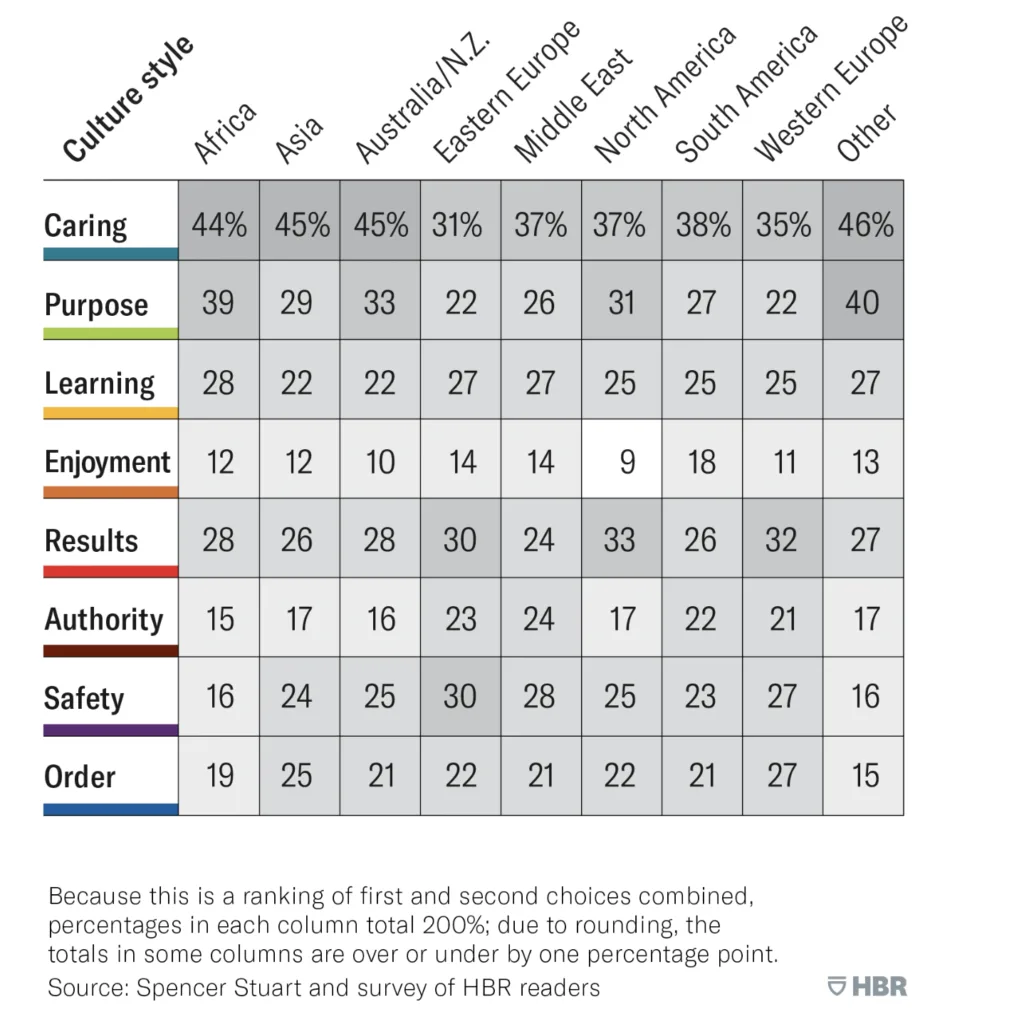Once you get far enough into your career, you will likely have experience with healthy team culture and, say, not-so-healthy ones.
Team culture consists of the shared values, attributes, and beliefs among the employees within an organization. As a leader, each and every single point is important to you, although some may matter more or less to different members of your team. Ideally, you will find a winning formula for creating a positive team culture that works for the most number of people. But if you are new to HR or struggling with a team that just doesn’t seem to click, a bit of insight might give you the boost you need to plant the seeds of improvement.
We will walk you through the most common examples of team culture types, with a few examples of what each of these team culture types may look like at your company.
Why is Team Culture important?
All successful organizations have one thing in common: Teams that work well together and enjoy the experience of working within their companies. And that is not just wishful thinking.
A 2022 Pew Research study found that half of the reasons people cite for quitting are directly related to culture. These include:
- No opportunities for advancement (33% indicated as a major reason)
- Felt disrespected at work (35% indicated as a major reason)
- Not enough flexibility to choose when to put in hours (24% cited as a major reason)
- Working too many hours (20% cited as a major reason)
- The employer required a COVID vaccination (8% cited as a major reason)
Depending on the situation, most of the others on the list could also potentially be workplace culture issues. “Pay was too low” was the top reason people quit, for example. It’s certainly not always the case that low pay is indicative of negative team culture, but it can be.
You get the point, though. Some reasons people quit will be obviously a result of a negative work culture experience. Others may be a bit less related. Ultimately, though, with half of the top-cited reasons falling right into the realm of “aspects of the job that management can easily control,” improving team culture is an absolute must.
Without a good team culture, both recruitment and employee retention will struggle. Identifying and attempting to recreate the different types of team culture is the first step to growing strong teams that can organically and actively help organization grow.
Here are the 8 most common types of team culture you might come across in your career.
1. Traditional culture
Traditional team culture is exhibited by the typical corporate image that most companies maintain. While many new organizations have let go of the strict dress codes, some aim to maintain a level of professional appearance as part of their branding. These companies employ the traditional team culture so they can operate in a risk-averse manner and manage clear expectations among employees.
The traditional team culture is common among organizations that value a certain level of professional conduct from employees. Before you cringe, note that this isn’t always a bad thing. Enterprise businesses (especially matrix organizations) with an international workforce may find that employees in different regions have different expectations for what the team culture should look like. Some will expect and feel more comfortable in a traditional culture, and may even view a less traditional culture as negative.
Harvard Business Review examined different company culture (and not team culture) styles across different regions.

While caring stands on top as the #1 feature of what most people want and expect to see within their company culture, “results,” “authority,” “safety,” and “order” outweigh “enjoyment” and, in some places, even exceed “learning.”
Just above this, we noted that “company culture” and “team culture” are not the same thing. And that’s because they aren’t. Different teams can have their own cultures that are unique and distinct from the company culture. That’s a great way to operate, especially if your company allows you to set a different tone and style for individual teams.
Don’t take this as free advice to go rogue and operate outside of company policy. If you can and you find it’s necessary, make slight adjustments toward a more traditional approach in a way that makes sense for your team based on their expectations, or even the expectations of your clients, consider it.
The following are examples of the traditional team culture:
- The CEO and board make the important decisions
- The company takes pride in its corporate history
- Task or assignment deadlines are clear and must be adhered to
2. People-first culture
People-first culture, also known as people-centric culture, is a type of team culture that focuses on, as the name suggests, its employees. People-first companies value and prioritize employee’s well-being and satisfaction. Putting the needs of workers first fits into current employee engagement and mentoring trends.

It can be tricky to adopt this type of team culture since many employers are naturally inclined to prioritize output over employees. But here’s the thing: Most of what your employees need doesn’t actually contradict the output. Instead, they tend to want things that will increase their effectiveness for both themselves and the company.
Learning and development is a great example of that. LinkedIn discovered that 94% of people would stay longer at their company if they were offered opportunities to grow their skills. Having a better-educated and better-trained workforce is better for business, and reducing turnover can save companies millions of dollars each year.
The idea behind the people-first company culture is that if your employees feel good and are happy with what they do, they are more likely to perform better. What’s more, happy and engaged employees are better team players. You need this kind of attitude to foster a strong team culture and collaboration.
The following are indicators of a people-first team culture:
- Employees frequently socialize outside of the office
- Team members are conscious of and take into account the concerns and struggles of colleagues
- People from different departments work well together and get along
3. Inclusive culture
An inclusive team culture puts diversity, equity, inclusion, and belonging (DEIB) at the forefront of its people strategy. This type of team culture places a large emphasis on ensuring all team members are welcomed, their ideas are championed and supported equally, and access to leadership and resources takes into account historic disadvantages.
Here are a few indicators of a company with an inclusive team culture:
- Employees are viewed as human beings and not as company resources
- The company offers personal and professional development opportunities for employees to reach their full potential
- The organization provides engagement support structures, such as ERGs
- Provide a work environment that employees find challenging and motivating
- Allow team members to influence company decisions, especially those affecting work quality
- Personalize employee benefits and EVP to fulfill their needs
4. High-performance culture
A high-performing team culture prioritizes quality over quantity in team performance and always strives to excel in their field. This work environment may often consist of high-performing individuals who are at the top of their game or are working their way toward becoming industry leaders. These individuals are often considered domain experts.
That said, companies with a high-performing team culture tend to recognize that the type of experience and skills needed for high performers must be cultivated internally. High-performing teams tend to put a large amount of time, energy, and resources into training and development.
Let’s leverage domain experts, shall we? In this Mentoring Soundbites, we explore how to use mentoring to support your high-potential employees and help them reach new heights in their skills and careers.
Don’t be too quick to consider this a negative team culture, though. Note that HBR’s company culture chart above shows many people worldwide prefer a results-driven team culture. That can be a positive, so long as the company doesn’t put results above all else.
When high-performance teams are backed by people-centered support, employees are driven to high performance because they are excited and happy to see the company grow, not because they are fearful of losing their jobs.
The following are examples of a high-performing team culture:
- Several opportunities for training and professional development
- Healthy competition among team members
- Visible opportunities for career advancement and career pathing
5. Competitive culture
Developing a competitive team culture is tricky. If done wrong, you will find yourself with a toxic work environment on your hands rather quickly. However, being competitive as a prevailing culture in your organization does not always have to be a bad thing. Competition can be healthy, as long as you work to avoid issues of shame or negative social, emotional, and job-based consequences for not being the “winner.”
You can build a great culture around competitiveness while maintaining a team-first mentality. That’s especially the case if your competitive culture is built around competing with market or business competitors instead of competing internally against each other.
The following are indicators of a properly-crafted competitive culture:
- A high degree of collaboration among teams
- Strong focus on skill development and upskilling
- Mentoring strategies in place that emphasize the preservation of internal knowledge
- Sustained focus on leadership development and succession planning
6. Collaborative culture

Another example of a strong team culture is one that focuses on collaboration. The best way to demonstrate this type of workplace culture is when there are several opportunities for employees to work within a team. You will also find that peer mentoring plays a strong part in how these teams work and grow together.
Collaborative team culture is common among startups, as the limited number of employees requires them to work closely together. However, because 92% of Fortune 500 companies offer mentoring programs, it’s clear that the largest and most successful organizations value collaboration among teams as well as individual team growth.
The primary benefit of collaborative team culture is transparency in communication and constant feedback. All team members are able to work cohesively as a unit.
The following are examples of a collaborative culture in the workplace:
- Executive leaders are involved and seek insights from associates through reverse mentoring
- Senior managers and team leaders constantly ask employees to pitch ideas
- There is a focus on providing several methods of communication outside of email
- An agile work environment facilitates ease of collaboration on projects
7. Post-merger culture
A post-merger team culture is when two companies (or more) come together as one. It is a period of transition where companies and their employees try to get a feel for what the new culture will be like. It also opens the door to new growth opportunities. Soon enough, as the team is able to adjust, the now unified company will experience greater stability.
The post-merger culture may not last long, and that’s a good thing. More likely than not, the companies that are merging have slightly different team cultures. Both cultures will compete for control of the cultural narrative going forward. A post-merger environment is a great time to make sure a positive team culture wins out.
Here are tell-tale signs of a post-merger team culture:
- Lots of avenues for open discussions
- New ideas coming head-to-head with old ones
- Possibility of high turnover
- Period of apprehension about changes to benefits
- A significant amount of uncertainty mixed with excitement
8. Affiliative culture
Team culture can also be based on leadership style. Affiliative culture is the best example of this.
According to Gallup, the behavior of leaders has a huge impact on the level of employee engagement. When management shows support to their employees and ensures their teams feel empowered and valued, the success of the company increases. On the other hand, employees who feel neglected are not as productive.
Key indicators of a company with an affiliative culture include:
- Executive leaders do not instill fear
- Reverse mentoring is prioritized
- Clarity and transparency exist in all kinds of communication
- Leaders are actively conscious of how their decisions impact their workers
- Leaders regularly offer praise and recognition
Companies That Are #Winning on Team Culture
The best way to learn about building a great team culture is to look at the example set by other successful companies and organizations. You don’t have to follow the exact same approach used by these companies, but you can use them as a source of inspiration if/when you want to improve yours.
- Google is one of the best examples of a company with a good team culture. Google’s company culture is focused on making a social impact on a global scale, using its products or services to deliver positive contributions to the world. Among the company objectives include promoting sustainability, inclusive marketing, and expanding opportunities.
- IBM chairman Thomas Watson Sr. is recognized as the first to introduce the concept of team cultures. IBM’s company culture of THINK focuses on using machines to enable people to work faster and more efficiently. They aim to use technology to push the limit of human achievement.
- HubSpot’s team culture is embodied in the acronym HEART. This positive team culture focuses on employee satisfaction by giving them autonomy and flexibility.
How to Promote a Healthy Team Culture
Senior leaders and management should focus on implementing activities that promote an effective team culture. The following are a few ideas that you can use to achieve your aim.
Involve leadership and management
Management and leadership styles will have a huge influence on the type of team culture within the organization, whether leaders admit it or not. Senior managers will serve as advocates of your company culture.
Lacking the right leaders? Mentoring can help you find, identify, and promote diverse leaders to key positions. Watch this Mentoring Soundbites video to learn more.
If you want to make a culture shift, assess your current leadership style and how it affects the rest of the organization. This is important if there are any negative attributes that impact your employees or block you from achieving your desired team culture.
Continue to monitor the managerial activity to ensure that it is aligned with your company’s long-term objectives and target culture.
Start with the recruitment
The easiest way to build and foster a good team culture is to hire people who best represent your desired organizational culture. It is easier to maintain your culture when your company is made up of people who embody the skills and values that you aspire for.
Lean on your HR team or other leaders to identify the qualities or attributes that are most desirable among new hires. At MentorcliQ, for example, that means hiring individuals who are fully committed to inspiring connection, boosting motivation, and ultimately increasing employee engagement, development, and retention in the workforce through our mentoring platform. Better and faster alignment with your mission and culture always happens during the recruitment and hiring phase.
Reward employees who embody your great company culture
“Reward” does not necessarily mean anything physical or monetary (although that’s always a plus for your employees!). Rewarding an employee who embodies your team culture could look like:
- Public recognition
- Promotions
- An extra day off work
- A raise
- A bonus
- Gifts or prizes
As with any type of recognition, make it public, and make it known why that team member is getting recognized. Just be sure to make this type of recognition regular so that as many employees as possible get recognized as possible, and at a regular cadence.
When possible, leave executive leaders off the list. While they certainly deserve recognition for their contributions to the company and should be praised at the right times, always praising executive leaders can come off as self-serving to your employees.
A Great Team Culture Takes Time
There’s no overnight success with team culture. Trying to create a new company culture or repairing one that is broken will definitely take a large amount of planning and a heavy amount of investment from everyone. That’s why mentoring is such an essential part of the process.
It’s simple:
- Identify the culture leaders in your organization, e.g., those who would exemplify the culture you want to build
- Select these individuals as mentors
- Match culture leaders with new hires and existing employees
Often, the reason why team culture turns negative is that the most positive and influential voices are not heard. Identify those individuals, train them, and then get them into 1:1 or group mentoring engagements with your teams. Then, watch the magic happen.





